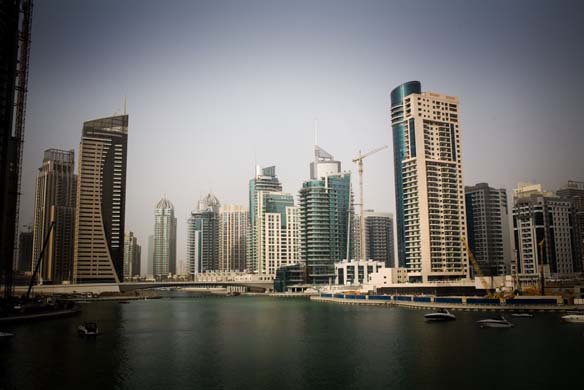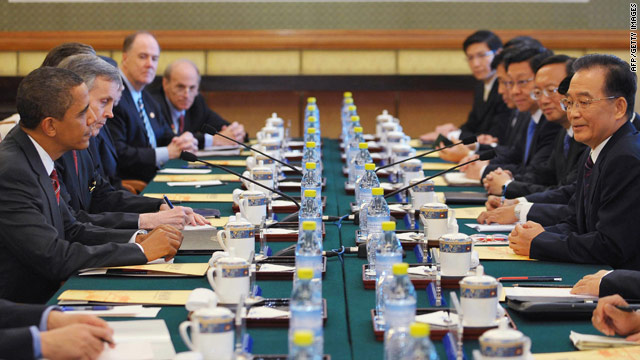Arab tycoons wrapped in traditional headscarves sipped fruit juice cocktails as they watched Russian models twirl in silk dresses.

It was the most exclusive ticket in town, a private catwalk show to which the Middle East's biggest spenders had been personally invited.
But if the smiles at this week's Dubai fashion event looked more false than usual, it was for a reason. The net worth of the VIPs in attendance today is a fraction of what it was six months ago.
A six-year boom that turned sand dunes into a glittering metropolis, creating the world's tallest building, its biggest shopping mall and, some say, a shrine to unbridled capitalism, is grinding to a halt.
Dubai, one of seven states that make up the United Arab Emirates (UAE), is in crisis.
So too are British expatriates. Many of the estimated 100,000-strong community came here expecting to make millions in property, and to soak up a lavish lifestyle living alongside footballers, actors and supermodels.
But the real estate bubble that propelled the frenetic expansion of Dubai on the back of borrowed cash and speculative investment, has burst.
Many westerners are being made redundant or absconding before the strict legal system catches up with them.
Half of all the UAE's construction projects, totalling $582bn (£400bn), have either been put on hold or cancelled, leaving a trail of half-built towers on the outskirts of the city stretching into the desert.
Among the casualties is the tower Donald Trump promised would be "the ultimate in luxury", a $100bnresort complex by the beach, and four huge theme parks and an artificial island developed by the state company Nakheel.
It is not all bad news: the building projects still in play are almost the equivalent of the US stimulus package. And the city remains a haven for super-rich sheikhs, billionaire hedge fund managers and Russian oligarchs.
But banks have stopped lending and the stock market has plunged 70%. Scrape beneath the surface of the fashion parades and VIP parties, and the evidence of economic slowdown are obvious. Luxury hotels are three-quarters empty. Shopkeepers in newly-built malls are reporting a drop in sales. In Dubai you expect to see a Ferrari parked beside a Rolls-Royce. But not, as is the case now, with scruffy For Sale signs taped to the windows.
Living the dream
Nowhere sums up the fortunes of expatriates in Dubai quite like Palm Jumeirah, an artificial island fanning out into the Persian Gulf, populated by residents including the likes of David Beckham, Michael Schumacher and even, it is said, Afghanistan's president, Hamid Karzai.
At the top of the island stands the Atlantis, a garish $1.5bn hotel complex with 1,539 rooms and a whale shark swimming in a 1 million-litre fish tank.
The Atlantis's $20m inauguration celebration, where the world's A-list celebrities were treated to 1.7 tonnes of lobster and 1,000 bottles of Veuve Clicquot, was promoted as the world's biggest party.
For Palm residents, it was followed by an equally impressive hangover. The value of their villas and apartments on the Palm fell by as much as 60% in just a few months.
"Drink your last cocktail and get out of here," said Sasha Reynolds, a 33-year-old airhostess. "My boyfriend is an engineer and work has dried up. He's been offered work in Qatar but who wants to go there? People are still making money here but the parties aren't quite the same. I'm lucky ‑ I didn't buy."
The exact number of unemployed is not known. The Dubai government does not release figures, and prevents the press from running stories that damage the economy, such as mass redundancies.
But there were sacked expatriates ‑ bankers, lawyers and architects ‑ in all but one of the hotel bars visited in Dubai this week.
Employees who lose work in the UAE automatically have their visa rescinded, generally giving them 30 days to leave.
"I look out of my balcony every day and I see Brits by the pool on their laptops," said Andrew Hillocks, 29, a sacked telecoms consultant whose passport has been seized. He will be escorted to the airport next week. "They're looking for work that just isn't there. I sold my car to cover my loan, but other people are panicking."
Under Dubai's strict legal code defaulting on debt or bouncing a cheque is punishable with jail. Any expatriate in financial difficulty knows the safest bet is to take the next outbound flight.
At the airport, hundreds of cars have apparently been abandoned in recent weeks. Keys are left in the ignition and maxed out credit cards and apology letters in the glove box.
Officials put the number of vehicles at 11. "No one believes that. There are 11 cars abandoned just on my street," said Anne, 26, a fashion editor from London. "Over the past two months I've been getting an email a day from people trying to sell their stuff. 'New Jaguar – need to sell before the end of the week'."
In a world of self-made millionaires and property entrepreneurs, some remain bullish. Simon Murphy, 42, runs the exclusive Crest of Dubai social club for Palm residents. "My job is to keep people smiling," he said.
The former hedge fund adviser's apartment is a "boy's paradise". Beside the snooker table and darts board are photos of him beside Richard Branson, Alan Shearer and Pele.
"I have the beach there. My local is that bar a couple of yards away. That's the pier where they're going to dock the QE2. People ask about the whole 'living the dream' scenario? Ain't this it?"
Some people had to lose out, he said. "As they say: eagles fly with eagles. The motivating factor to come here is greed. You have to be selfish, have minimal social responsibility, and want to make money quick. Brits in Dubai are gamblers. It's the nature of the beast that not everyone wins."
The invisible losers
In the Dubai however, the losers are the invisible majority.
Taxi drivers from Egypt, Yemen and Iraq compete for work. Their clients often ask to go to hotel bars where, at night, they will find prostitutes from Eastern Europe, Africa and Asia.
Expatriates from the developing world maintained Dubai's orgy of consumption during the boom years. Now they too are being forced to leave.
Perhaps those who suffer most are the construction workers from the Indian subcontinent, who have worked on perilous building sites earning as little as £70 a month.
The Indian embassy is reportedly anticipating an exodus with 20,000 seats on flights to India already "bulk-booked" for next month.
Buses come to pick up 250 workers every night from one dusty street on the edge of Sonapur, a labour camp on the edge of the desert.
As night falls, the gangly silhouettes of construction workers file out of the camp gates. "There is no work," said Jasvinder Singh, 24, placing his suitcase in a pick-up truck, the words "Dubai to Delhi" taped to the side.
"It has been such a drama. We came here to earn money. We are going home to see our wives but our pockets are empty."
Sanjit, 44, another construction worker from Punjab, gestures angrily in the air: "We were treated badly here. We were slaves to the Arabs."
But unlike their British counterparts, construction workers from India, Bangladesh and Pakistan cannot abandon lives in the glove compartment of a 4x4. Most took loans to pay agent fees to come to Dubai, and their debts will follow them home.
"I sold our land and took loans in the village to come here," said Imran Hassan, a 20-year-old Bangladeshi farmer. "I paid the agent £2,000 to bring me. He said I would earn 1,500 dirham [£287] a month, but we are paid 572 dirham. When I return people in the village will want their money but I have none."
A Welsh construction site manager said he had protested to his boss about the treatment of labourers.
"We tell them to bring their clothes to work one day and then we send them home. It makes me feel sick. I asked why it had to be done so quickly and I was told a lot of them commit suicide and we don't want that on our hands."
Tale of two cities
Dubai's future will actually be decided well way from the shimmering skyscrapers.
To find out why, you need to drive along 90 miles south along the Gulf coastline, past tiny Bedouin enclaves and shimmering desert mosques.
Abu Dhabi, the oil-rich capital of the UAE and the richest emirate, has opted for a more conservative – and, some say – prudent approach to growth that contrasts with Dubai's giddy expansion.
But it boasts 95% of the UAE's oil reserves and more than half of its GDP, and regional experts predict it will overtake Dubai as the destination of choice for westerners in the Middle East.
Dubai, which has barely a trickle of oil in comparison, is projecting a 42% increase in public spending on infrastructure projects, to compensate for vanishing private investment. But it cannot go it alone. Abu Dhabi is increasingly expected to bail out its poorer neighbour, and the two ruling families are meeting regularly to decide how to transfer cash into Dubai's ailing economy.
"The question is not if Abu Dhabi will come to the rescue, but how big it will be and how public," a source with knowledge of the negotiations said. "Abu Dhabi cannot let Dubai sink."
But Abu Dhabi has its own problems. The emirate's sovereign wealth fund – once said to be worth $1 trillion – has taken a hit in the global recession, while the lifeblood of the economy – the price of oil – is down more than 60%.
Thirty miles from the capital, dust rises from the barren horizon where a 10km-long building site is being turned into al-Raha Beach, an $18bn waterfront city, a joint venture between Aldar, Abu Dhabi's largest property developer, and Laing O'Rourke, the UK's largest construction company.
"A lot of staff have been moved over here from Dubai," said Paul, 35, a Laing O'Rourke project manager, raising his voice over the noise of JCBs.
"But it is all coming to a stop here too. There are mass redundancies now. We've gone from an expat workforce of about 1,000 to about 400. There are more waves of redundancies coming this week."
He said he could not be sure, but by his estimate more than half of the al-Raha development had been quietly shelved.
"I've not been made redundant myself but I've decided to go home in April. The wife and kids have already left. A lot of people are jumping ship beforethere are no lifeboats left."
Back in Dubai the following day, a Mercedes Benz snaked along the city's main street, Sheikh Zayed Road. A 35-year-old Emirati property magnate dressed in traditional Arabic clothing sat in the driver's seat, listening as Veronica Chapman, 65, a real estate agent from Hull, recalled what the city was like when she first arrived in 1980.
"No milk, no bread, no schools. It was a desert and a couple of buildings," she said.
The developer slowed the car to point out abandoned building sites where cranes stood still in the baking heat. "Here we are completely reliant on foreigners," he said. "Maybe Dubai grew too fast."
· This article was amended on Wednesday February 18 2009 to conceal the identity of one of the sources.








